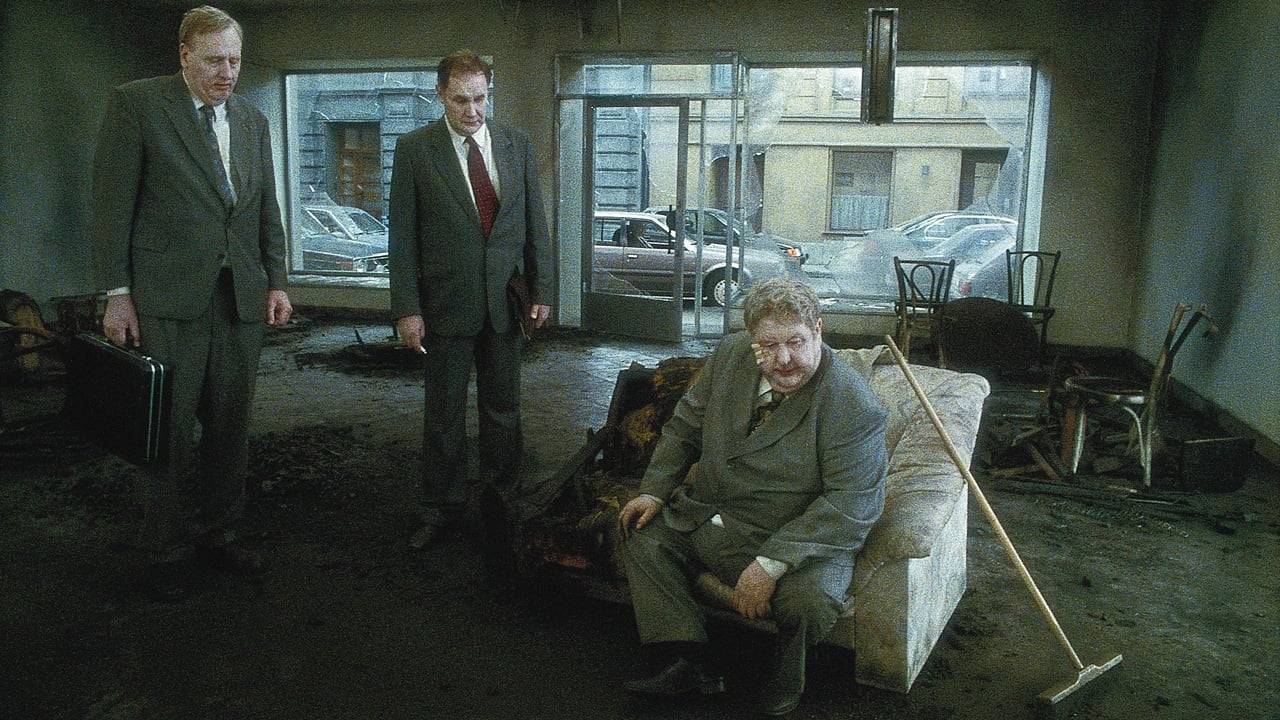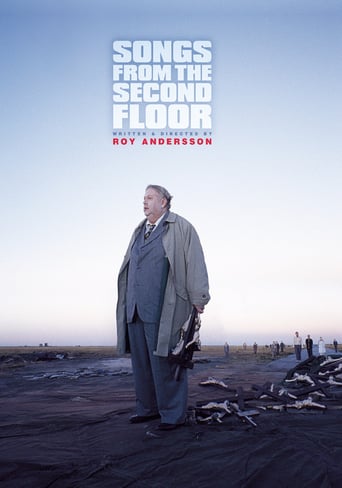

I loved some of the ideas presented here, but not so much the cold and empty execution. This is no fault of the film. It is just such a bizarre offering that its last concern is the audience. The film focuses on a bizarre city where time seems to have come to a halt. There are traffic jams, and people trying to get somewhere. However, very few seem to know where. One man is scared of the insurance men, after causing a fire, another has trouble with his stomach after an accident at a magic show. It's a film that requires you to sit and study, much like a poem. A lot of it is funny, such as the attention to detail. Seeing a parade of men in the background whipping each other is both unsettling but comical. It may have struck 10 years old, but a lot of the film has to do with accounts, brokers and businessmen. A repeated theme is the cost of business. This is still true, even more so today. Bizarre and interesting, but certainly a challenge.
... View MoreSongs From The Second Floor, is the second feature from director Roy Andersson, whose spent his career making according to fellow Swedish director and legend Ingmar Bergman, "The best commercials in the world"(Youtube his name for proff of this). Anderson takes an advertisers eye to this film and inverts it, into around 40 or 50 short vignettes, some with recurring characters, like the man seen on the cover who has burned down his business to collect the insurance but bumbled the job, while most include walkons, and many characters drift in an out of scenes before the movie ends. These short vignettes are nearly all deadpan and absurdist tragi-comic advertisements for peoples lives broken or on the verge of breaking. The antagonist, if there must be one, is capitalism(a subject which the commercial making Anderson is very much aware), and it's de-humaizing effects on all its touches. As bleak as all this sounds, the material is played more often than not for laughs. There's a traffic jam which has clogged the city as if everyone were leaving at the same time, a girl who is blindfolded and lead of a cliff by her village elders, a man accidentally sawed in half by poor magician, men and women in business suits walk down streets in parade's flailing themselves as an act of penance to God so he will prevent the further falling of stocks, and a man followed around by ghosts of friends and strangers. If that weren't enough each scene is composed with a static non moving camera, giving each vignette the detailed composition of a photograph or a painting. The movie could be considered a tragi-comic funeral song for western capitalism and modernity(the film takes place just before the new millennium I think), but a tag like that really doesn't communicate how humane, clever, funny, and accessible this movie really is. It's like a lyrical Monty Python film, or a an absurdist Ingmar Bergman, and yet again it's a film all it's own, structurally, conceptually, and aesthetically, if your interested in where film-making may be going in the future and right now, Songs From The Second floor, is the movie to see, and one of the best of the new millennium
... View MoreSongs from the Second Floor (2000) ****Tragic. Hilarious. Absurd. Those three words fit Roy Andersson's Songs from the Second Floor to a 't.' The film was a success at the 2000 Cannes film festival, winning the Jury Prize and gaining critical accolades internationally. The film is entirely unique, and magical creation of Andersson's mind. The film follows a number of individuals,some of whom are loosely tied together through personal connections, all of whom share in the existential dread and tragedy of life. We have a magician who nearly saws in half a volunteer, a fired employee, a businessman specializing in crucifixes, and another man who has lost his business to a fire (a fire which he admits he started), his family (including a son who has gone mad from writing poetry), and a series of other characters, not least of which a large congregation of businessmen who walk the streets amid a never ending traffic jam whipping themselves with chains. The story flows through vignettes, all captured in long shots by a camera that only moves once throughout the film. The city appears abandoned - save for the traffic jam and roaming flagellants. It's gray and dingy, as abstract a city as could ever be imagined. The people who inhabit it are drab and deathly pale - that the film opens with a man in a tanning bed becomes utterly hilarious in its irony as the film progresses. There are so many scenes of extraordinary surrealist absurdity that if one was to talk about them all they would need many more pages than available here. Let's consider a few of the most memorable though. In one scene, a woman uses a telephone to explain to someone on the other end that she is stuck in traffic, and cannot get out. She is in a bar; outside we see the line of traffic, moving only as slowly as conceivable without standing still. Everything appears gray, totally abstract as from some world where colours have never been invented. The atmosphere is surreal, and I realize as I describe it I do it no justice at all. Another brilliant scene involves what appears to be the cities entire population as they gather - businessmen and clergymen alike - to carry out the ritual sacrifice of a young girl, meant to stimulate the stagnating economy. Another excellent scene involves the man who has burned down his store, trying to explain to investigators what he's lost, only to be distracted by the passing hoard of businessmen whipping themselves. For me however the most amazing scene comes last. In a very long take, we see the crucifix man discard a truckload of his inventory in front of the arsonist. He leaves, and the arsonist takes out his large crucifix and sets it down. We realize that 4 or so individuals have been slowly walking down the road in the background throughout the scene. They've been following the arsonist earlier in the film asking for help. This time he throws a can at them to scare them off. To his and our surprise,dozens of other people seem to pop up out of nowhere from the ground in the surrounding field. What a shot; it's one of the best I've ever seen, and the camera never moves once throughout its duration. But I digress. What does it all mean? A quick search of movie message boards will lead you to a number of queries; the DVD also apparently has a commentary track by Andersson himself discussing and deconstructing the symbolism in the film (I have not seen this yet, and as of now am still unsure if I really want to). The film, I think, a scathing satire of modern society and capitalist realism. It's also about the dangers of mixing superstition and reality. Consider the flagellating businessmen, self-inflicting pain to stimulate the economy. The sacrifice of the young girl for the same purpose; this also simultaneously highlights how corporations expect us to march towards our deaths each day (ie cigarettes and alcohol, and so on). The man who burns down his business is shown to be greedy throughout, happy he doesn't have to repay a friend when he commits suicide; yelling at his institutionalized son for not understanding that the purpose of life is to buy something and sell it with one or two extra zeroes. Andersson has been called the slapstick Bergman, and surely is one of the most interesting products of Sweden. He had pulled a Malick like move prior to Songs from the Second Floor, not making a feature film for 20 some years (although he was active in directing shorts, docs, and commercials). His return was a glorious one though, and one that was entirely original, and entirely inspiring. This is a dark and tragic film, but one that is also funny in that darkest of dark, and absurdest of absurd ways.
... View MoreI have seen this movie for more then 10 times, but still not the amount of time the director redid the movie, or at least parts of it, to make it such a masterpiece! It's true that this movie will always be in my mind and it inspires me and gives me so much inspiration while working on my own movie. amazingYEs this is a must see, and when you see it, you will for sure always remember itThere are not much movie out there like this, and if you know them please tell mehave fun watching !!
... View More